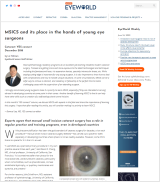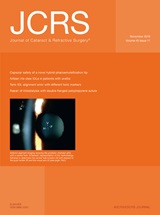ASCRS Focus on Cataract Surgery
Manual Small-Incision Cataract Surgery (MSICS)
June 2022 Update
Manual small-incision cataract surgery is a low-cost, small-incision form of extracapsular cataract extraction that is often employed in the developing world. It offers several distinct advantages over phacoemulsification in resource poor settings, including shorter operative time, less need for technology, and lower cost. MSICS has a role in regular practice and training programs and is a beneficial surgical tool for cataract surgeons across the globe.
This ASCRS Focus on Cataract features a variety of resources focused on the importance of MSICS and keys to mastering this technique.

MSICS Surgical Films
Manual Small-Incision Cataract Surgery
Browse these surgical films on MSICS from the ASCRS Film Festival.
In-Depth MSICS Instructional Courses
Courses are 90-minute instructional sessions that include Q&A time and interactive discussion among the instructors and audience. View these in-depth courses on manual small-incision cataract surgery from the 2022 and 2021 ASCRS Annual Meetings.
EyeWorld Article
 MSICS and its place in the hands of young eye surgeons
MSICS and its place in the hands of young eye surgeons
By Liz Hillman, EyeWorld Senior Staff WriterMost ophthalmology residency programs do an excellent job teaching residents modern cataract surgery. Trainees are getting more and more exposure to the latest technologies and techniques including the femtosecond laser, iris expansion devices, specialty intraocular lenses, etc. While staying cutting edge is important for any young surgeon, it is also important to know how to deal with complications and how to handle unique situations.
Read more on EyeWorld.org >>
EyeWorld Article
 MSICS and ECCE in the developed world
MSICS and ECCE in the developed world
By Liz Hillman, EyeWorld Senior Staff WriterShould surgeons still be trained and maintain skills in these procedures despite the prevalence of phacoemulsification?
Manual small incision cataract surgery (MSICS) has been touted as an ideal technique in developing countries where phacoemulsification equipment is expensive and not readily available.
Read more on EyeWorld.org >>
Resident's Learning Curve Analysis for Manual Small Incision Cataract Surgery (MSICS) Using Ico-Oscar Tool
Presented by Haripriya Aravind, MD
This paper was presented at the 2022 ASCRS Annual Meeting within the session SPS-106 Cataract Surgery - Techniques II.The purpose of this paper is to predict the average number of surgeries required for a resident to gain competence in manual small incision cataract surgery (MSICS) surgeon based on the International Council of Ophthalmology-Ophthalmology Surgical Competency Assessment Rubric (ICO-OSCAR).
JCRS Article
 Visual outcomes of high-volume compared with low-volume manual small-incision cataract surgery in Nepal.
Visual outcomes of high-volume compared with low-volume manual small-incision cataract surgery in Nepal.
Journal of Cataract & Refractive Surgery: August 2020Purpose: To study if manual small-incision cataract surgery (MSICS) in a high-volume setting gives acceptable postoperative visual outcomes.
Read more on the JCRS Website >>
JCRS Article
 Outcomes of manual small incision cataract surgery and phacoemulsification in eyes with chorioretinal coloboma
Outcomes of manual small incision cataract surgery and phacoemulsification in eyes with chorioretinal coloboma
Journal of Cataract & Refractive Surgery: September 2021Purpose: To evaluate outcomes of manual small-incision cataract surgery (MSICS) and phacoemulsification in eyes with chorioretinal coloboma.
Read more on the JCRS Website >>




